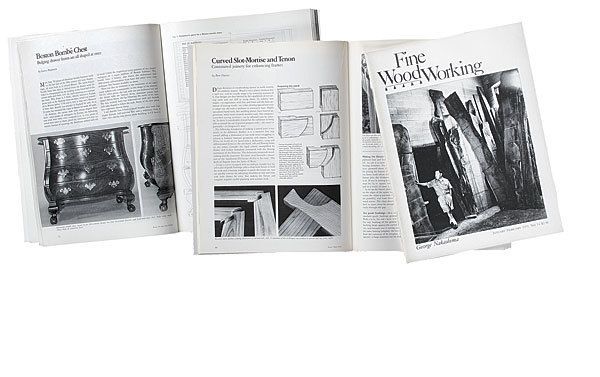40 Years of Inspiration
How Fine Woodworking influenced generations of woodworkers
Synopsis: Over the course of your relationship with Fine Woodworking, can you remember a particular article or series that had an impact on you? We talked to a bunch of our longtime contributors—all of them prominent woodworkers—to see which articles over our 40-year history have influenced them, and why. Their answers are both entertaining and enlightening.
Read the original articles that inspired our contributors:
(available for a limited time)
Fine Woodworking magazine debuted in the winter of 1975, after founders Jan and Paul Roman sent postcard invitations to 20,000 potential subscribers. Four decades later, the impression the magazine has made on the craft is clear—and everlasting. Fine Woodworking has fostered a creative community, preserved and advanced a craft, inspired and taught everyone in it.
“I remember waiting with anticipation to see what the first issue was going to be all about,” recalls period furniture maker and teacher Phil Lowe. “Here you had this publication that was sort of letting the trade secrets out. It has played a tremendous role in keeping the craftsmanship alive.”
The magazine also became an important showcase, creating a common awareness—that hadn’t existed before—of what was current in the craft. “I love seeing what other people are doing,” said furniture maker Hank Gilpin. “What are the different minds in different parts of the country developing and creating, and where is their inspiration?”
To celebrate Fine Woodworking’s 40th anniversary, we asked many of our most noteworthy contributors to tell us what reading the magazine has meant to them, and to share their favorite article. Taken together, their stories are like pieces in a marquetry pattern depicting the magazine’s influence.
FWW #3—the whole issue
Garrett Hack is a man of many pursuits: furniture maker, author, teacher, gentleman farmer. So it’s no surprise that he would choose more than one favorite article. He instead chose an entire issue—#3. The issue’s table of contents reads a little like a lineup card for the ’27 Yankees, stacked with some of woodworking’s heaviest hitters: Tage Frid, R. Bruce Hoadley, and Jere Osgood among them. Frid’s article on mortise-and-tenon joinery is one that Hack still uses in his teaching.
“I always admired the way he wrote quite simply about things,” Hack said, recalling some of the article’s lessons: “Don’t use four shoulders around a tenon. Keep your tenons as wide as possible. Angle the tenon instead of the mortise. “That’s lasting stuff.”
Hack also took heart from Osgood’s article, which celebrated and commented on the furniture craftsmanship then being practiced in the Northeast. At that time, in the summer of 1976, Hack had done some woodworking in school and recalls that he was beginning to weigh the role that the craft might play in his future. In hindsight, he said, FWW #3 may have helped tip the scales. “The following year, I applied to a program in artistry which Jere Osgood was running,” he recalled. “So that was in some ways the first step.”

















Log in or create an account to post a comment.
Sign up Log in